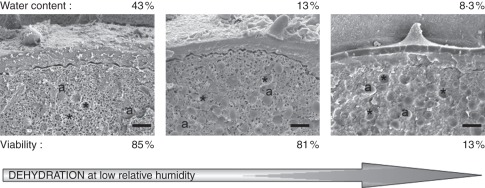Fig. 3.
Cryo-fractures of Cucurbita pepo pollen observed with a cryo-SEM after freeze-drying (10 min at –90 °C in a vacuum of 5 × 10−8 hPa). The sites containing water appear as vesicle-like structures (dark holes) in the cytoplasm. These vesicles are highly abundant in the cytoplasm of C. pepo pollen from just-opened anthers (water content 43 %). They decrease in pollen dehydrated to 13 % water content and they are no longer evident in pollen dehydrated to 8·5 % water content. Amyloplasts (a) and their imprints (asterisks) are evident in C. pepo pollen. Pollen viability is high at both 43 and 13 % water content, but it decreases drastically upon further dehydration to 8·5 % water content. This degree of dehydration is induced by pollen exposure to 30 % relative humidity for 90 min (see data in Nepi et al., 2010). Pictures were taken at the Department of Plant Cytology and Morphology, University of Wageningen, The Netherlands, in 1999 using a JEOL 6300F field emission cryo-SEM. Scale bar = 2 µm.

